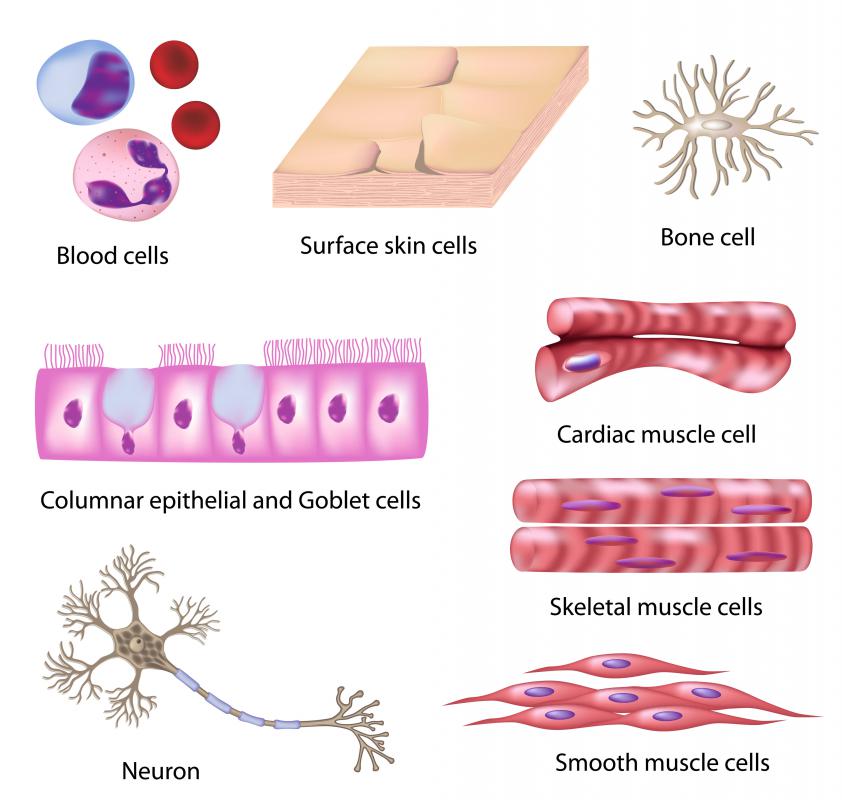At TheHealthBoard, we're committed to delivering accurate, trustworthy information. Our expert-authored content is rigorously fact-checked and sourced from credible authorities. Discover how we uphold the highest standards in providing you with reliable knowledge.
What are the Different Parts of Human Cell Structure?
The main parts of human cell structure can be divided into the outer plasma membrane, the usually central nucleus, the cytoplasm, and the different organelles that are found in the cytoplasm. The plasma membrane is the outer boundary of the cell and controls what enters and leaves it. The nucleus has a special membrane of its own and contains the cell's deoxyribonucleic acid (DNA). The cytoplasm contains supporting structures and fluid as well as organelles that lie between the nucleus and plasma membrane. The organelles are different structures that have unique functions in the cell.
Mostly made of lipids, the plasma membrane gives human cell structure its basic shape and contains the other parts of the cell. It separates the intracellular parts inside the cell from the extracellular space outside of it. The plasma membrane regulates what enters and exits the cell through different chemical processes. It has sites on the outside, called receptors, that receive chemical messages from other cells and allow cells to communicate with each other. Human cell membranes also have unique markers that allow other cells to tell the difference between them and foreign cells like bacteria.

The cytoplasm forms the rest of human cell structure, excluding the nucleus. The fluid part of the cytoplasm contains enzymes as well as other proteins and molecules. The cytoplasm also contains a framework that gives human cell structure its basic shape. Also found in the cytoplasm are the cytoplasmic organelles, some of which are involved in making and transporting proteins or in providing energy for the cell.

The cytoplasmic organelles are responsible for performing a number of special cell functions. One example is the ribosome, which is one site where proteins are made. The mitochondria are often thought of as cellular power plants because they provide energy for the cell. The Golgi apparatus changes proteins and lipids and transports them to other parts of the cell. A lysosome is a structure that can break down lipids, proteins, and other molecules. Lysosomes are sometimes called the cell's digestive system.

In human cell structure, the nucleus is considered an organelle but has unique features and functions of its own. One of these features is a double membrane that more tightly regulates what can enter and leave the nucleus. The nucleus contains the cell's DNA, which it uses in a modified form to direct the production of proteins and all of the cell's enzymes. It also contains the parts of DNA that form chromosomes when a cell divides.
AS FEATURED ON:
AS FEATURED ON:















Discussion Comments
@strawCake - The outer cell member stuck in my head too when I took biology. A cell in the human body couldn't function without its outer membrane, after all. I distinctly remember being really fascinated by the channel proteins in the membrane too. They were shaped a certain way that only some compounds could pass through the proteins and get inside of the cell.
I also thought the nucleus was pretty cool. After all, it holds the DNA, which controls everything the cell (and by extension the whole human body) does.
When I took biology I remember being completely amazed by the outer plasma membrane, as well as the interior cell membranes in human body cells. It's amazing that cell membranes can pretty much let certain materials through and not others.
The interior membranes actually allow a lot of different processes to go on in the cell at once by partitioning different areas off. That way all kinds of chemical reaction can go on at once without bothering one another. And the compounds that are part of those reactions can't move into other parts of the cell where they aren't needed. It's really amazing!
Post your comments